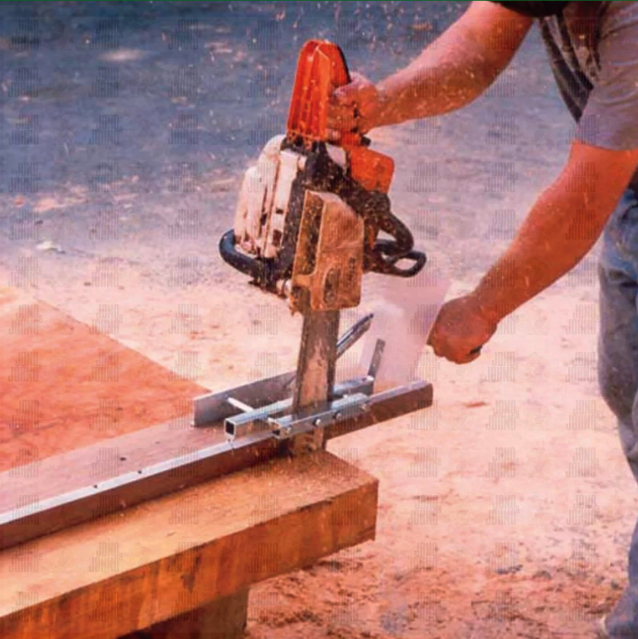A chainsaw is a powerful and potentially dangerous tool that can cause serious injury if not properly maintained. Even small issues, like the chainsaw sputtering at an inopportune moment, can lead to mistakes in your cut. A branch might snap unexpectedly, or the chainsaw could get stuck inside the tree, creating a hazardous situation. Your chainsaw should cut straight and true. If it starts to veer off course or makes crooked cuts, it's often a sign of underlying issues. A chainsaw sharpener may be needed, or you might need to replace the cutting teeth entirely. Here’s what you can do if your power tool is cutting unevenly. There are several reasons why a chainsaw might start cutting crooked. The issue could be with the chain itself, the bar, or even how you're using the tool. Common problems include a dull or uneven chain, incorrect tension, worn top plates, or damaged cutting teeth. The chain is the key component that does the actual cutting. If it's not sharpened evenly or becomes dull, the chainsaw will not make straight cuts. This is especially true when working with hard wood or over time as the chain wears down. Investing in a high-quality chain, such as a Stihl model, can help reduce the frequency of sharpening and improve performance over time. Chain tension plays a crucial role in how well the saw performs. Too tight, and the chain can become damaged or break. Too loose, and it risks coming off the bar, which can be extremely dangerous. Adjusting the tension is a simple task that takes just a few minutes and can significantly improve the performance of your chainsaw. The top plate of the chain is the part that actually cuts through the material. If these are uneven or worn, it can cause the saw to cut in an inconsistent or crooked way. A damaged or worn chainsaw bar can greatly affect the performance of the chain. It’s responsible for guiding and supporting the chain as it moves. If the bar is not in good condition, it can lead to uneven cuts and potential safety hazards. Even if you know how to sharpen a chainsaw chain, it’s possible that some of the cutting teeth have been damaged. This can happen from accidentally hitting stones, dirt, or other hard objects while cutting. The depth gauge helps control how deep the chain cuts into the wood. If it's not set correctly, it can result in uneven or inconsistent cuts. Adjusting the depth gauge is an important step in maintaining the performance of your chainsaw. If your chainsaw isn't cutting straight, there are steps you can take to fix it. Here's how to sharpen your chainsaw properly and effectively. Before you begin sharpening, it's essential to clean the chain thoroughly. Any dirt, oil, or debris on the chain can interfere with the sharpening process and make it harder to achieve a consistent edge. Soak the chain in a mixture of water and ammonia to remove grease and residue. Rinse it well and dry it before proceeding. Once the chain is clean, adjust the tension so it's slightly loose but still secure on the guide bar. This ensures smooth movement without excessive strain on the chain. Use the tensioning screw located on the side of the chainsaw to fine-tune the tightness. Begin by sharpening the shortest cutter on the chain. This ensures all teeth are the same length. You can always shorten longer teeth, but you can’t make a short one longer. Mark the first tooth you sharpen to keep track of your progress. Hold the file at the correct angle as specified by the manufacturer. This helps maintain the original shape and effectiveness of the cutting teeth. File each tooth five to six times, then move to the next one along the chain. After sharpening one side, reverse the chainsaw and file the remaining teeth. Make sure you’re filing within the notch of the blade, not on the outside. Finally, check the depth gauges to ensure they are shorter than the adjacent cutters. If they extend beyond the chain, it can prevent proper cutting and must be filed down to the correct level. A chainsaw that cuts in a zigzag pattern is not only inefficient but also dangerous. Using a quality chainsaw sharpener is one of the best ways to restore its performance and ensure it cuts straight and true. Don’t forget to maintain other parts of your equipment for optimal results. Jono & Johno offers a wide range of chainsaw tools, including sharpeners, replacement chains, and safety gear. Whether you're a professional or a DIY enthusiast, we have everything you need to keep your chainsaw in top condition. Visit our website to explore our full inventory, or reach out to us with any questions. We're here to help you stay safe and productive in your work. Aluminum profiles have emerged as essential building materials, revolutionizing the construction industry with their versatility, durability, and aesthetic appeal. These profiles, composed of lightweight yet sturdy aluminum, have become a cornerstone in modern architectural design and construction. Whether in residential, commercial, or industrial settings, aluminum profiles offer an array of benefits that contribute to energy efficiency, structural integrity, and aesthetic excellence. From windows and doors to curtain walls and interior partitions, aluminum profiles enable architects, builders, and designers to realize their creative visions while adhering to the demands of sustainability and functionality. Building Materials,Building Supplies,Building Materials Supply,Construction Materials,aluminum windows Foshan Knilex Aluminum Co., Ltd. , http://www.aluprofilefactory.com
Common Causes of Crooked Chainsaw Cuts
Uneven Chain Sharpness or Dull Chain
Incorrect Chain Tension
Uneven Top Plates
Worn Out Chainsaw Bar
Damaged Cutting Teeth
Improper Depth Gauge
How to Sharpen Your Chainsaw Chain Like a Pro
Step 1: Clean the Chain
Step 2: Adjust Chain Tension
Step 3: Start with the Shortest Cutter
Step 4: File at the Correct Angle
Step 5: Finish with the Opposite Side
Step 6: Check the Depth Gauges
Find Quality Chainsaw Sharpeners at Jono & Johno